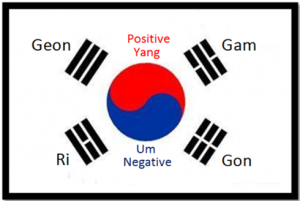- Korean Flag (태극기: Taegukkuki)
 There is a lot of meaning in the Korean flag, which is also called Taekkuki (referring to the Yin and Yang halves of the circle in the center of the flag. The flag consists of three parts: the white background, the red and blue circle in the center and four trigrams, one in each corner of the flag.
There is a lot of meaning in the Korean flag, which is also called Taekkuki (referring to the Yin and Yang halves of the circle in the center of the flag. The flag consists of three parts: the white background, the red and blue circle in the center and four trigrams, one in each corner of the flag.
The white background of the flag means peace. The red and blue circle in the center is called ‘Taeguk’, the origin of all things in the universe. The central thought is perfect harmony and balance: A continuous movement within the sphere of infinity, resulting in one unit. The blue part of ‘Taeguk’ is called ‘Eum’ or in Chinese, Yin, and represents all negative aspects of the balance while the red part is called ‘Yang’ and describes all the positive aspects. The circle itself represents unity – bringing together the negative and the positive, while the Yin and Yang represent the duality. Examples of duality are heaven and hell, fire and water, life and death, good and evil, or night and day.
The four trigrams at the corners (called ‘Kwe’ in Korean) also communicate the concept of opposites and balance. Representing the four classical elements, the The trigrams are heaven (upper-left 3 solid bars), fire (bottom left corner – 2 solid bars with split middle bar), water (top right corner – 2 split bars with solid middle bar) and earth (bottom right – 3 split bars).
Symbolic of the nation is the white background (the land), the circle (people), and the four trigrams (the government). All three make up the essential elements of the nation.
- Travel Landmarks in South Korea
Gyeongbokgung, Insadong, and Samcheongdong (Seoul)
Haeundae Beach in Busan (Pusan)
Jeju Island (Jejudo)
Korean Folk Village (Seoul)
Hahoe Village and Andong (Andong)
Bulguksa Temple and Seokguram Grotto (Gyeongju)


